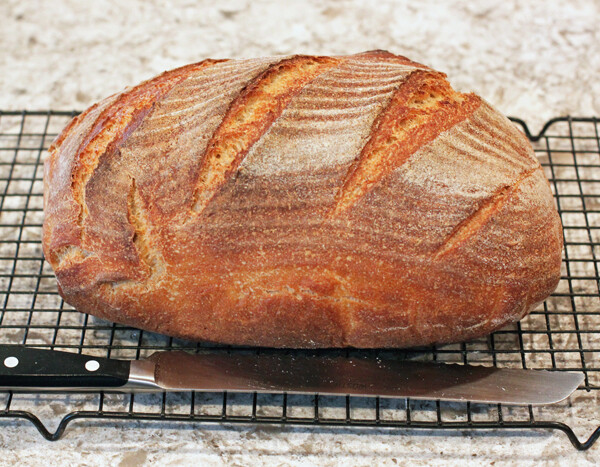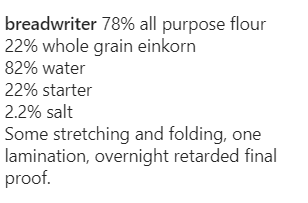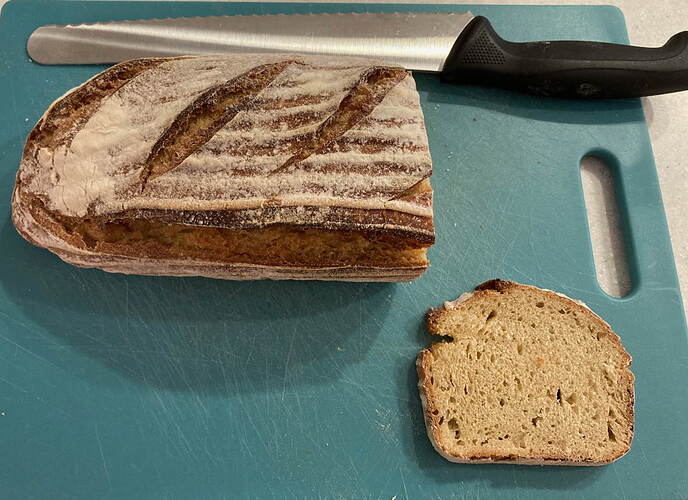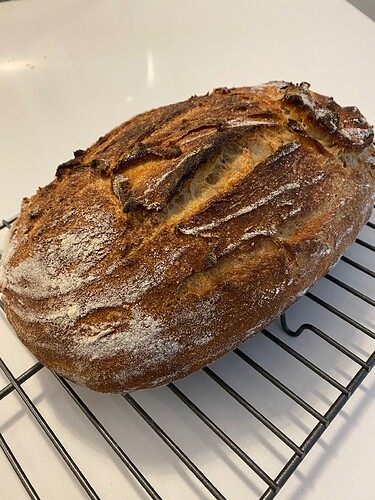I almost forgot to add thank you for getting the book! There is a white no knead (first recipe) and a lot of tips, including how to make any of the recipes more or less whole grain. Eric and I are always here to answer questions you have about the recipes too.
Yes im looking forward to the book coming!! Feeling a little shell shocked with my first flop atttempt can only get better! Im still working so will have to wait for Friday night to try the white sourdough recipe will keep you posted.
Hi Melissa and Eric, I received your book and am finding it very helpful, thankyou! i just baked my first loaf of No Knead sourdough with white flour and success not perfect but better than my first loaf of bread last week even tastes good! I think the most difficult part for me is figuring out when it is ready to bake in the final proof!! Our house tends to be around 72degrees but since we have snow now which is unusual!! for Vancouver island the wood stove is making it warmer in the house. i ended up proofing for just over 2 hours not sure maybe I should have waited not sure?
It’s very hard in the beginning to know when to put the dough in the oven. I never found the poking test to be particularly helpful, but it can’t hurt to do. (Gently poke the dough with your finger, and if the dough doesn’t spring back, it’s ready or past ready to bake.)
Keep observing the dough before you put it in the oven, and the results you get when you take it out. Eventually, you’ll develop a sense of what proofing appearance/time/temp gets you what results.
Edited to add this advice I just gave in a different thread 
There are a lot of recipes with before and after photos of the bulk and the final proof in the Breadtopia blog. Scroll to the photo gallery after the printable recipe in this one for example. You can see some expansion in the basket, but not a lot.
Hello davehames,
That’s a lovely-looking loaf, both crust & crumb. What were the flour & water proportions for this, and types of flour? Thanks for sharing! ~ Patricia
Hello Eric, does oil also promote potential burning?..I did that once, but never again!
Also, do I understand correctly that parchment paper typically is used specifically for wet doughs?..like no-knead breads, to transfer from worksurface to baking vessel.
And is parchment paper not necessary for other bread doughs with less hydration?
Thanks for clarifying! ~ Patricia
omgosh, that lovely lava-like crust!
PLBT, I use 16 oz bread flour, 8 oz fresh milled whole wheat flour (white or red), 16 oz water, 2 tsp salt and 1/3 cup starter. It winds up with 67% hydration this way. The Yecora Rojo wheat makes a great tasting flour for this bread too. I had to increase the baking times for the extra dough. I bake it covered for 45 minutes in a 475°F oven, then cover it and drop the oven down to 450°F for 10 or 15 more minutes until done.

In an abomination of the scientific method I altered a number of variables of v1 of the no knead recipe. In order to hone in on the main problems early, can y’all suggest which might be the most relevant for the closed crumb?
From my notes:
NOTES
3/13/21 - used einkorn ( half WW, half AP) instead of reg WW. Used KA mixer, rest 15-20 min then dough hook for 1-2 min, rest 20 min repeat dough hook, scrape together and let sit covered over night. VERY, VERY wet dough. Surfaces exudes microdroplets of water. I had to add lots (½ cup +) after bulk to handle. Cooked in hot elongate covered clay bread pan after > 90 min proof. Removed from oven at 208 degF. - Closed crumb with holes at periphery. Mildly overly moist. Great looking crust. Tangy (not to my taste) Not as tasty as spelt. Starter from fridge fed 5-6 hours and left at room temp. - not especially bubbly.
- Apparently einkorn is low gluten so maybe that was the problem.
Thanks,
David - Dallas
@davidwat Good morning, David. The following website is one of the best I’ve found for “all things einkorn.” There are video tutorials on how to build and grow your own einkorn sourdough starter to baking beautiful loaves of einkorn bread. I hope this helps. https://jovialfoods.com/
Baking blessings,
Leah
Einkorn and all purpose flour at 50:50 are indeed gluten challenged, and that bread slice looks pretty good to me. I baked a fairly airy 40% einkorn several months ago, but it was paired with bread flour, which is stronger and I think I did some gluten development to make the dough more manageable.
You may want to mix your dough in the morning so you can keep an eye on it during the day and make sure it doesn’t overferment, another thing that makes any dough feel loose and soupy.
As you noted, you’re probably going to want to use less water in your dough with einkorn flour.
In this bread below, einkorn was only 22% of the total flour, and I got away with 82% water, but that is challenging – benefited from gluten development and shaping experience.
With 50% einkorn, I’d probably go down to 75% or lower water.
And all einkorn flour, I’d use 70% water and a loaf pan to hold it together.

I’ve now made 3 very disappointing (as in one of them was terrible) loaves in a row. I’ve been baking no-knead bread for years now and I still can’t turn out a consistently handsome loaf. After this most recent bad run, I decided that my starter was not performing so I kept it out of the fridge and fed it every day in an effort to get it going again. Perhaps I need better instructions for when, exactly, to USE the starter. I’ve seen two different instructions: feed 4-8 hours before (leave out on counter during this time?) and the other one from this site calling for just a half teaspoon of starter and letting the dough proof for 10-12 hours on the counter, shaping and proofing 2nd time (for heaven knows how long, it usually looks ok one minute then sunken the next) then putting the basket in the fridge for another 10 hours till I’m ready to bake.
Other note is that the Artisan Sourdough recipe is always very wet for me and I’ve had real problems with it sticking to the liner. Years ago I ruined a basket with this problem (even using rice flour) so I switched to a liner because at least that’s washable. I guess I need to just add more flour.
I think it’s rarely a good idea to rely on the time guidelines of a recipe – whether for the starter ripeness or for the actual fermentation of the dough.
The most straightforward rule to follow regarding starter is to feed it and use it when the starter has reached its peak expansion (approximately).
If you feed your starter on a clock, you risk feeding it when it’s not particularly hungry, or when it’s been starving for hours and hours at room temperature. Do that enough and it won’t behave very predictably in a dough and it may actually cease to leaven bread. Starter is super hardy, don’t get me wrong, but there’s also a rhythm or life cycle to the microbes.
Here’s a great FAQ on feeding starter (the 5th tab down):
And this blog post should help with the timing of your bread fermentation.
This article has some shorthand tips about flour and fermentation e.g. wetter dough ferments faster.
85% is 442 gms
I’m about to make this for the first time. For no particular reason, I’ve given relatively little thought to the no knead options out there. At the moment, though, my family and I are living out of suitcases and my baking equipment isn’t with us (but my starter of course is…). So this option seems promising this week! I’ll try to post results in the next day or so.
Good luck with your travels and your no knead baking. You can make delicious low-key bread on repurposed equipment. You might miss all your tools (bench knife is a big one for me!) but you’ll be eating well.
I actually made this loaf. My first sourdough bread ever and what a process! I coaxed the starter to life using Breadtopia’s dry starter. I put the bread together after watching the terrific video about 10 times, reading lots of the Forum (people are so helpful!) and used the same baker. It did flatten some, and the top is kind of messy, but maybe that’s because I forgot to put the liner into the proofing basket, making it stick. I had to shake it like crazy to get it out. I wish it tasted a little more tangy, too. Oh, it very quietly crackled as it was first cooling! I love that sound. I’m so, so happy I was able to do it. It’s flawed, but more than good enough. Thanks for the recipe and wonderful videos. I appreciate that the videos try to simplify things in an uncomplicated, direct way.
Excellent loaf. Loving that crumb and can’t believe it’s your first sourdough. Enjoy!
P.s. Rice flour (the non glutinous kind) is made for for bannetons. And don’t shake the banneton. By all means give it a light tap but allow gravity to do the work. You can tare the dough by shaking it. However with rice flour it shouldn’t be a problem.
Hi Abe - Thanks for the compliment and advice. I did use some rice flour, but not enough and next time I won’t use any wheat flour at all. Next time I also won’t shake the dough and will just let it fall from the banneton into the baker, no matter how long it takes. I’ve been baking yeasted bread on and off for years. I switched to no-knead breads in 2020 since less yeast is used in the recipes, and no yeast was available to me for months. I was too nervous to try sourdough until last week and I’m so glad I did!
Anyone know the approximate calorie count per slice of this bread?



